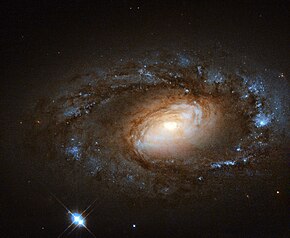NGC 4102
| NGC 4102 | |
|---|---|
 NGC 4102 image taken by theHubble Space Telescope | |
| Observation data (J2000epoch) | |
| Constellation | Ursa Major[1] |
| Right ascension | 12h06m23.115s[2] |
| Declination | +52° 42′ 39.42″[2] |
| Redshift | 0.002792[3] |
| Heliocentric radial velocity | 837 km/s[4] |
| Distance | 59.6Mly(18.3Mpc)[5] |
| Grouporcluster | Ursa Major group[6] |
| Apparent magnitude(V) | 11.2[7] |
| Apparent magnitude(B) | 11.8[8] |
| Characteristics | |
| Type | SAB(s)b,[9][10]SABab[3] |
| Apparent size(V) | 2.9′×1.8′[7] |
| Notable features | LINER[9] |
| Other designations | |
| IRAS12038+5259,2MASXJ12062311+5242394,WISEJ120623.07+524239.8,UGC7096,LEDA38392,MCGMCG+09-20-094,PGC38392,SDSSJ120623.00+524240.1[8] | |
NGC 4102is anintermediate[9]barred spiral galaxylocated in the northernconstellationofUrsa Major.It is visible in a small telescope and has anapparent visual magnitudeof 11.2.[7]The galaxy was discovered April 12, 1789 byWilliam Herschel.J. L. E. Dreyerdescribed it as "bright, pretty small, round, brighter middle and bright nucleus".[11]This galaxy is located at a distance of 60[5]millionlight yearsand is receding with a heliocentricradial velocityof 837 km/s.[4]It is a member of theUrsa Major groupof galaxies.[6]
Themorphological classof NGC 4102 is SABab[3]or SAB(s)b?,[10]which is a spiral galaxy with a bar-like feature around the core (SAB), no inner ring structure (s), and moderately tightly-woundspiral arms('ab' or 'b'). However, the bar in this galaxy is considered particularly small for galaxies of this class.[10]Thegalactic planeis inclined at an angle of56°±2°to the line of sight from the Earth.[12]NGC 4102 has a region of intense star formation in the nuclear region, known as astarburst region.[6]This volume is 1,000 ly (310 pc) in diameter containing some 3 billionsolar masses.[13]An outflow of hydrogen has been detected, extending outward to the northwest as far as 6.3 kpc (21 kly) from the nucleus.[14]
The core of NHC 4102 is almost certainly anactive galactic nucleus(AGN),[15]which indicates it has asupermassive black hole(SMBH) that is generating energy by accreting material.[16]It is anX-ray sourcewith aspectrumsimilar to aSeyfert 2 galaxy.[15]This type of AGN is known as a Type-2LINER,or low-ionizationnuclearemission-lineregion. This is due to a core that is obscured by intervening dusty materials and/or the SMBH is accreting material in an inefficient manner. Thebolometric luminosityof the active nucleus is~7×1043erg·s−1.[16]
Onesupernovahas been observed in NGC 4102: SN 1975E (type unknown, mag. 16.7).[17]
References
[edit]- ^ab"This is no supermodel spiral".www.spacetelescope.org.ESA/Hubble.Retrieved2 December2014.
- ^abcSkrutskie, Michael F.; et al. (1 February 2006)."The Two Micron All Sky Survey (2MASS)".The Astronomical Journal.131(2): 1163–1183.Bibcode:2006AJ....131.1163S.doi:10.1086/498708.ISSN0004-6256.S2CID18913331.
- ^abcdAnn, H. B.; et al. (2015). "A Catalog of Visually Classified Galaxies in the Local (z ~ 0.01) Universe".The Astrophysical Journal Supplement Series.217(2): 27.arXiv:1502.03545.Bibcode:2015ApJS..217...27A.doi:10.1088/0067-0049/217/2/27.S2CID119253507.
- ^abcTully, R. Brent; et al. (2016)."Cosmicflows-3".The Astronomical Journal.152(2): 21.arXiv:1605.01765.Bibcode:2016AJ....152...50T.doi:10.3847/0004-6256/152/2/50.S2CID250737862.50.
- ^abcLianou, S.; et al. (November 2019). "Dust properties and star formation of approximately a thousand local galaxies".Astronomy & Astrophysics.631:19.arXiv:1906.02712.Bibcode:2019A&A...631A..38L.doi:10.1051/0004-6361/201834553.S2CID174801441.A38.
- ^abcdBeck, Sara C.; et al. (October 2010). "NGC 4102: High-resolution Infrared Observations of a Nuclear Starburst Ring".The Astrophysical Journal.722(2): 1175–1179.arXiv:1008.1800.Bibcode:2010ApJ...722.1175B.doi:10.1088/0004-637X/722/2/1175.S2CID118849324.
- ^abcdO'Meara, Steve (2007).Herschel 400 Observing Guide.Cambridge University Press. p. 98.ISBN9780521858939.
- ^abc"NGC 4102".SIMBAD.Centre de données astronomiques de Strasbourg.Retrieved2021-12-22.
- ^abcd"NED results for object NGC 4102".NASA/IPAC Extragalactic Database.Retrieved8 December2014.
- ^abcdErwin, Peter; Debattista, Victor P. (June 2013). "Peanuts at an angle: detecting and measuring the three-dimensional structure of bars in moderately inclined galaxies".Monthly Notices of the Royal Astronomical Society.431(4): 3060–3086.arXiv:1301.0638.Bibcode:2013MNRAS.431.3060E.doi:10.1093/mnras/stt385.
- ^abSeligman, Courtney."NGC 4102 (= PGC 38392)".Celestial Atlas.Retrieved2021-12-23.
- ^abVerheijen, Marc A. W. (December 2001). "The Ursa Major Cluster of Galaxies. V. H I Rotation Curve Shapes and the Tully-Fisher Relations".The Astrophysical Journal.563(2): 694–715.arXiv:astro-ph/0108225.Bibcode:2001ApJ...563..694V.doi:10.1086/323887.S2CID18676545.
- ^ab"Hubble Spies Charming Spiral Galaxy Bursting with Stars".SpaceDaily. 8 December 2014.
- ^abTrent Braun, Timothy; van Zee, Liese; Richards, Emily E.; McQuinn, Kristen B.; Skillman, Evan D.; Edges (January 2015). "Detection of an Extended Outflow in NGC 4102".AAS Meeting #225.225.American Astronomical Society.Bibcode:2015AAS...22525027T.250.27.
- ^abcMathur, Smita; et al. (October 2008).Finding Local Low-mass Supermassive Black Holes.Observational Evidence for Black Holes in the Universe: Proceedings of the 2nd Kolkata Conference on Observational Evidence for Black Holes in the Universe held in Kolkata India, 10-15 February 2008 and the Satellite Meeting on Black Holes, Neutron Stars, and Gamma-Ray Bursts held 16-17 February 2008. AIP Conference Proceedings. Vol. 1053. pp. 43–49.arXiv:0807.0422.Bibcode:2008AIPC.1053...43M.doi:10.1063/1.3009521.
- ^abcGonzález-Martín, O.; et al. (March 2011). "Suzaku observation of the LINER NGC 4102".Astronomy & Astrophysics.527:10.arXiv:1012.3080.Bibcode:2011A&A...527A.142G.doi:10.1051/0004-6361/201016097.S2CID53470087.A142.
- ^Transient Name Server entry for SN 1975E.Retrieved 29 March 2023.
External links
[edit] Media related toNGC 4102at Wikimedia Commons
Media related toNGC 4102at Wikimedia Commons
